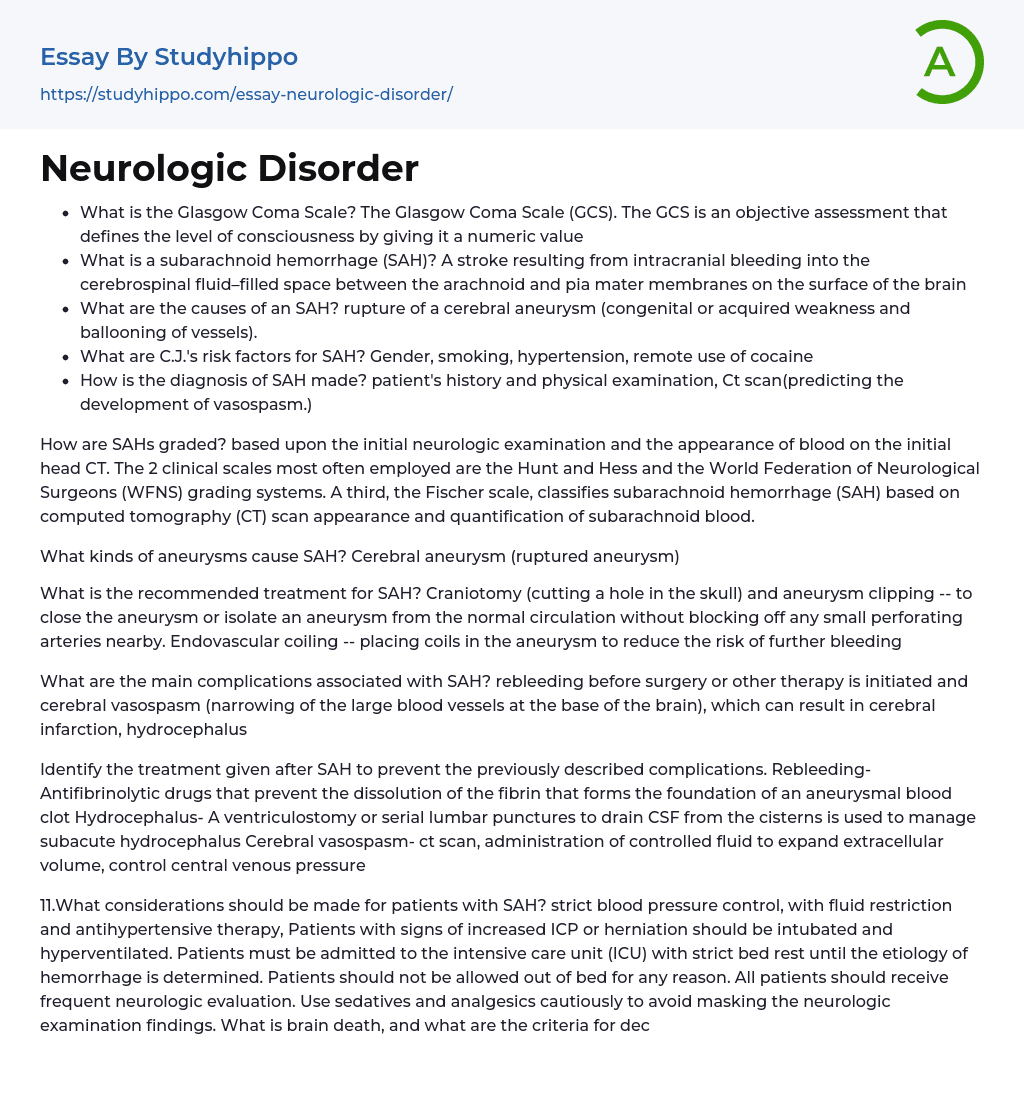The Glasgow Coma Scale (GCS) is a numeric assessment that objectively defines the level of consciousness. A subarachnoid hemorrhage (SAH) is an intracranial bleeding stroke occurring in the space between the arachnoid and pia mater membranes on the brain's surface, filled with cerebrospinal fluid. SAHs can be caused by cerebral aneurysm rupture, which is the weakening and ballooning of vessels acquired or congenitally. Risk factors for SAH include gender, smoking, hypertension, and remote use of cocaine for C.J. The diagnosis of SAH involves considering patient history, physical examination, and CT scan to predict vasospasm development. Grading systems for SAHs include the Hunt and Hess and World Federation of Neurological Surgeons (WFNS). The Fischer scale is used to classify subarachnoid hemorrhage (SAH) based on CT scan appearance and quantification of subarachnoid blood; this scale determines the types of aneurysms that cause
...SAH. There are several recommended treatment options for SAH, including Craniotomy - involving creating a hole in the skull - and aneurysm clipping to close or isolate the aneurysm without obstructing adjacent small perforating arteries.Another option for decreasing the risk of further bleeding in aneurysms is Endovascular coiling, where coils are placed inside the aneurysm. Complications associated with SAH include rebleeding prior to treatment initiation, cerebral vasospasm which narrows main blood vessels at the base of the brain and can result in cerebral infarction, as well as hydrocephalus. To prevent these complications following SAH, antifibrinolytic drugs are administered to prevent breakdown of fibrin that forms a blood clot in the aneurysm. Subacute hydrocephalus can be managed through techniques such as ventriculostomy or serial lumbar punctures for draining cerebrospinal fluid (CSF) from cisterns. For treating cerebral
vasospasm, interventions like CT scans and controlled fluid administration are used to increase extracellular volume and control central venous pressure. Patients with SAH should strictly adhere to blood pressure control, limit fluid intake, and receive antihypertensive therapy. Those experiencing symptoms of heightened intracranial pressure or herniation must undergo intubation and hyperventilation.
Patients admitted to the intensive care unit (ICU) must remain on strict bed rest until the cause of their hemorrhage is determined. It is vital for patients to avoid leaving their beds at all times. Furthermore, regular neurologic evaluations should be conducted for all patients. Careful administration of sedatives and analgesics is necessary to avoid obscuring the results of neurologic examinations. Familiarity with the criteria for brain death and the procedures for declaring a patient clinically brain dead is crucial. Brain death serves as both a medical and legal confirmation of death.
A comprehensive physical examination conducted by a qualified physician, typically a neurologist, has determined that the patient, referred to as C.J., meets the criteria for brain death, including unresponsiveness, absence of reflexes, and inability to breathe without a ventilator. Legally declared brain dead, C.J., who had previously expressed her desire to be an organ donor, will have her wish fulfilled by her husband. However, he has inquiries regarding the donation process. In order to ensure only viable organs are obtained for transplantation purposes, thorough screening of the potential donor is necessary. The organ procurement agency will assess the patient and review her medical records to determine suitability for donation. Simultaneously, C.J.'s assigned nurse will provide ongoing ventilator support while also monitoring kidney, liver, and pancreas function through laboratory tests. Additionally,vital signs will be closely
observed alongside medication administration in order to maintain adequate blood flow and glucose levels.
- Emergence essays
- Anxiety Disorder essays
- Post-traumatic Stress Disorder essays
- Central Nervous System essays
- Sleep essays
- Traumatic Brain Injury essays
- Epilepsy essays
- autism essays
- Alzheimer's Disease essays
- Sleep Deprivation essays
- Action Potential essays
- Blood essays
- Body essays
- Brain essays
- Childbirth essays
- Eye essays
- Glucose essays
- Heart essays
- Human Physiology essays
- Immune System essays
- Kidney essays
- Muscle essays
- Nervous System essays
- Neuron essays
- Poison essays
- Puberty essays
- Sense essays
- Skeleton essays
- Skin essays
- Addiction essays
- Anatomy and Physiology essays
- Biodegradation essays
- Cancer essays
- Dental Care essays
- Disability essays
- Disease essays
- Disorders essays
- Health Care essays
- Infectious Disease essays
- Inquiry essays
- Intelligence Quotient essays
- Lung Cancer essays
- Medicine essays
- Neurology essays
- Nutrition essays
- Olfaction essays
- Physical Exercise essays
- Public Health essays
- Sex essays
- Women's Health essays




